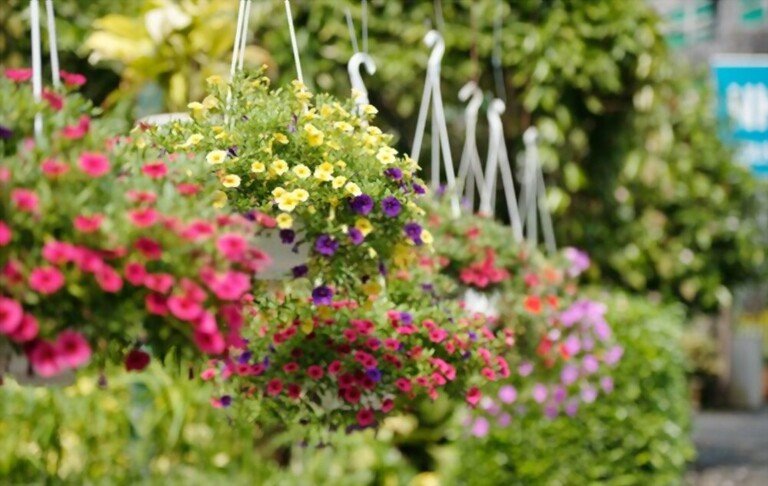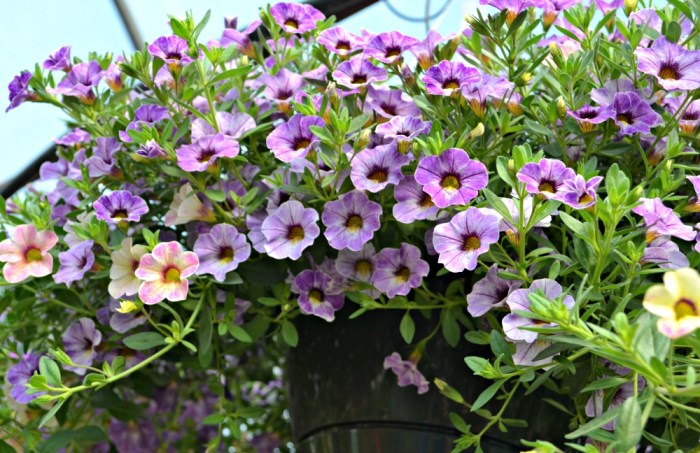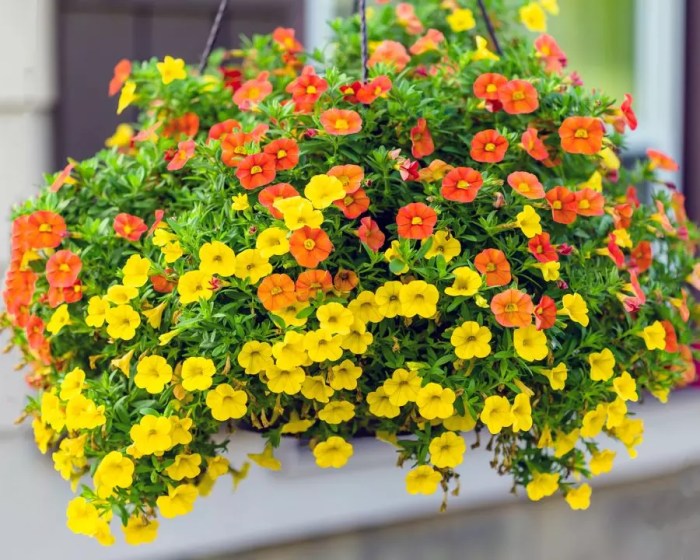Hanging plants that like morning sun bring a touch of nature indoors, creating a serene and inviting atmosphere. These plants thrive in the gentle rays of the morning sun, showcasing their vibrant foliage and delicate blooms. From trailing vines to lush ferns, there’s a wide variety of hanging plants to choose from, each with its unique charm and character.
Whether you’re a seasoned plant enthusiast or a novice gardener, this guide will provide you with all the essential information you need to care for your hanging plants that love morning sun. We’ll cover everything from choosing the right varieties to watering, pruning, and design ideas.
Plant Varieties and Characteristics

Hanging plants that prefer morning sunlight exhibit a range of species and characteristics, each with unique attributes that enhance their suitability for this specific light exposure.
The following table compares different hanging plant varieties suitable for morning sun, providing insights into their growth habits, foliage characteristics, and bloom times:
Table of Hanging Plant Varieties for Morning Sun
| Plant Variety | Growth Habit | Foliage Characteristics | Bloom Time |
|---|---|---|---|
| Spider Plant | Trailing | Long, narrow leaves with variegated stripes | Spring to fall |
| Pothos | Trailing | Heart-shaped leaves in shades of green or variegated | Rarely blooms indoors |
| English Ivy | Trailing or climbing | Small, lobed leaves in dark green or variegated | Spring to fall |
| Ferns | Bushy or trailing | Delicate, feathery fronds in various shades of green | N/A (do not produce flowers) |
| String of Pearls | Trailing | Succulent, bead-like leaves | Rarely blooms indoors |
Sunlight Requirements and Placement: Hanging Plants That Like Morning Sun

Hanging plants that thrive in morning sun require specific amounts and duration of sunlight for optimal growth. Understanding their sunlight needs is crucial for selecting the ideal placement and ensuring their well-being.
Determining Sunlight Exposure
The optimal amount of morning sunlight for these plants ranges from 4 to 6 hours. To determine the ideal placement, observe the direction of the sun during the morning hours. East-facing windows or balconies provide ample morning sunlight without the harsh afternoon sun.
Location Selection
The following table provides a guide for selecting the best location based on sunlight requirements:
| Sunlight Requirement | Ideal Placement |
|---|---|
| 4-6 hours of morning sun | East-facing windows or balconies |
| Partial shade (2-4 hours of morning sun) | North-facing windows or balconies, or under a shade cloth |
| No direct sunlight | Indoor locations with bright indirect light |
Watering and Nutrient Management

Maintaining proper hydration and nutrient supply is crucial for thriving hanging plants that relish morning sunlight. Understanding their specific watering needs and nutritional requirements ensures optimal growth and aesthetic appeal.
Watering Frequency and Techniques
The frequency of watering depends on factors such as plant species, pot size, and environmental conditions. As a general rule, allow the top inch or two of soil to dry out before watering again. Water deeply and thoroughly, ensuring the water reaches the roots.
Avoid overwatering, as it can lead to root rot and other issues.
Nutrient Requirements and Fertilization
Hanging plants require a balanced supply of nutrients, including nitrogen, phosphorus, and potassium. Choose a fertilizer specifically formulated for houseplants and follow the instructions on the label. Generally, fertilize monthly during the growing season and less frequently during winter.
Common Watering and Nutrient-Related Issues, Hanging plants that like morning sun
- Overwatering:Yellowing leaves, stunted growth, and root rot. Reduce watering frequency and improve drainage.
- Underwatering:Wilting leaves, brown leaf tips, and slow growth. Increase watering frequency and ensure the soil is moist but not soggy.
- Nutrient Deficiency:Yellowing or pale leaves, stunted growth, and poor flowering. Fertilize regularly and choose a fertilizer with a balanced NPK ratio.
Pruning and Maintenance
Maintaining the health and aesthetic appeal of hanging plants requires regular pruning, pest management, and occasional repotting. Pruning and trimming encourage healthy growth, prevent legginess, and promote a fuller appearance. Additionally, proper handling of pests and diseases is crucial to safeguard plant health.
Repotting and propagation techniques ensure the plant’s continued vigor and aesthetic charm.
Pruning Techniques
Regular pruning is essential for hanging plants. Use sharp, clean shears to remove dead or damaged leaves, stems, and spent flowers. Trim back leggy stems to encourage bushier growth. For plants that tend to grow long and viney, such as pothos or philodendron, you can prune them to a desired length to maintain a compact shape.
Pest and Disease Management
Hanging plants can be susceptible to pests and diseases like aphids, mealybugs, and powdery mildew. Monitor your plants regularly for signs of infestation or infection. Treat infestations promptly with insecticidal soap or neem oil. For powdery mildew, increase air circulation and apply a fungicide.
Repotting and Propagation
As hanging plants grow, they may need to be repotted into larger containers. Choose a pot with drainage holes to prevent waterlogging. Use a well-draining potting mix specifically designed for hanging plants. Propagation is another way to maintain and expand your collection of hanging plants.
For those seeking to add a touch of elegance to their indoor space, hanging plants that thrive in morning sun offer a perfect solution. Their cascading foliage and vibrant hues bring a sense of tranquility to any room. Among these, varieties with white flowers, such as the trailing white petunia or the delicate snowdrop, exude a timeless charm.
Their blooms, reminiscent of pure white petals, add a touch of ethereal beauty to any setting, complementing the vibrant greens of the surrounding foliage.
Take cuttings from healthy stems and root them in water or soil.
Design and Display Ideas
Hanging plants offer a versatile and visually appealing way to incorporate greenery into any space. They can be used to enhance privacy, create vertical gardens, or add a touch of elegance to balconies and patios.
When designing a hanging plant display, consider the style of the space, the amount of sunlight available, and the size and shape of the plants. For a modern look, opt for sleek and geometric planters. For a more traditional style, choose classic hanging baskets or macrame hangers.
Plants that thrive in bright, indirect light, such as ferns, philodendrons, and pothos, are ideal for indoor hanging displays. For outdoor spaces, choose plants that can tolerate direct sunlight, such as succulents, geraniums, and petunias.
Hanging Plants for Privacy
Hanging plants can be used to create a sense of privacy on balconies or patios. Place them along the perimeter of the space, or hang them from the ceiling to create a living screen.
When looking for hanging plants that thrive in morning sunlight, consider artificial hanging plants from Bunnings. These artificial hanging plants bunnings offer the same aesthetic appeal as live plants without the need for watering or sunlight. They can complement natural hanging plants that prefer morning sun, creating a lush and vibrant indoor oasis.
Vertical Gardens with Hanging Plants
Hanging plants can be used to create vertical gardens, which are a great way to add greenery to small spaces. Install a trellis or grid on a wall, and hang plants from it. You can create a lush, living wall that adds both beauty and air purification to your home.
Hanging plants that thrive in the gentle glow of morning sun add a touch of tranquility to indoor spaces. From the trailing tendrils of pothos to the delicate fronds of ferns, these plants bring nature’s beauty indoors. For more inspiration on transforming your home with hanging plants, visit hanging plants for indoors , where you’ll find a comprehensive guide to choosing and caring for these enchanting additions to any room.
Whether you’re seeking a pop of color or a calming touch of greenery, hanging plants that love morning sun will brighten your indoor sanctuary.
Hanging Plants for Balconies and Patios
Hanging plants are a great way to add a touch of greenery to balconies and patios. Choose plants that are well-suited to the amount of sunlight available, and hang them from the ceiling or walls. You can create a cozy and inviting outdoor space that you’ll love spending time in.
Last Recap

With proper care and attention, hanging plants that like morning sun can thrive for years to come, adding beauty and tranquility to your home. Whether you’re looking to create a lush indoor jungle or add a touch of greenery to your patio, these plants are sure to impress.
User Queries
What are some of the best hanging plants for morning sun?
Some popular hanging plants that thrive in morning sun include pothos, spider plants, ferns, and hoyas.
How often should I water my hanging plants?
The frequency of watering will depend on the type of plant, but most hanging plants will need to be watered about once a week.
How can I prevent my hanging plants from becoming leggy?
To prevent legginess, give your hanging plants plenty of bright, indirect light and prune them regularly.